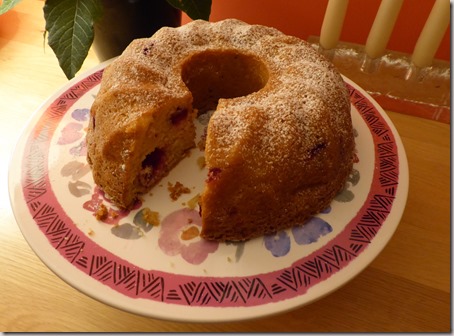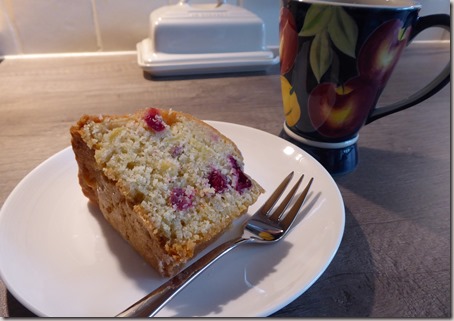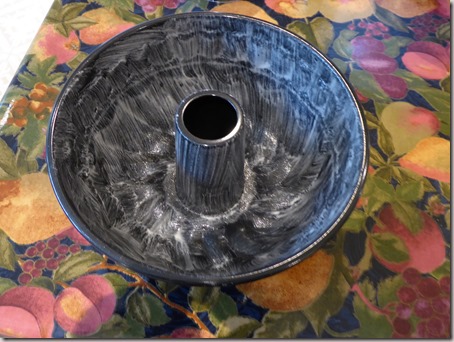
This cake came about because when I was rummaging in the fridge veg drawer for a carrot or two I spotted the box of fresh cranberries I had bought for Christmas. I had been full of good intentions of making my own cranberry sauce to go with the turkey but then I completely forgot and we had a jar of sauce instead.

Wondering what I could do with them two weeks after the event, I had an idea. There were also some apples and a large orange looking unloved in the fruit bowl so I decided to adapt the Mary Berry recipe for the apple and apricot cake and see how it turned out. You can see that recipe
here. I substituted cranberries for the apricots and orange zest for the almond essence. I used a ring tin instead of an ordinary round tin.

It turned out beautifully, in two ways. I have to say that this is probably the nicest cake I have made in a long time. The cranberries gave little bursts of sharpness in every mouthful, in contrast with the sweetness of the apples and the warmth of the orange.

Quite delicious and one to add to my list of cakes that I shall definitely make again.
The other way it turned out really well was in using a home made cake release paste.

I do find preparing Bundt tins a real pain. Getting melted butter into all those nooks and crannies, then dusting with flour, is a messy job and not easy to get right. Turning them out is always stressful and I have had to disguise many a damaged cake with crafty icing in the past. Equally I have had success with bought cake release in spray or liquid form but have been somewhat unsure about some of the ingredients and frankly some of them smell slightly unpleasant.
This stuff is a revelation, easy to make from storecupboard ingredients. I put equal quantities of each component in my mini chopper and blitzed them to a paste.

It was easy to brush onto the tin and get into the crevices in a nice, even layer. I cooled the cake in the tin for ten minutes and it slipped straight out on inverting it. No tapping, shaking or cursing needed! I can’t wait to try it on one of my more intricate Bundt tins.

You can see numerous recipes for it on the internet and most suggest it can be stored in a jar at room temperature. That’s the only bit I’m unsure about. It’s good that it’s completely natural with no added chemicals, but logic tells me I should keep it in the fridge. But then it might be too stiff to use next time I need it. So it resides in my kitchen cupboard for now and if it turns into something green and triffid like I’ll report back!
The cake had a nice, golden and slightly crisp outer crust which I attributed to the cake release. It was not at all unpleasant, in fact it gave the cake a nice finish. It will be interesting to see if the same kind of crust occurs every time I use the paste.
Update - on reading about the cake release in other places I decided to keep it in the fridge after all. I'm pleased to say that it is still easy to brush into the tin straight from the fridge.
Apple, orange and cranberry cake
Ingredients
250g self raising flour
1 tsp baking powder
225g caster sugar
2 eggsfinely grated zest of 1 orange
150g butter, melted and cooled
225g apples, peeled*
120g fresh cranberries (I expect frozen ones would work too)
Method
Preheat the oven to 160 C / 140 Fan / gas mk 3. Grease a Bundt tin or ring tin with home made cake release (see below), or butter and line the base of a 20cm round loose bottomed tin.
Put all the ingredients except for the fruit into a large bowl and mix well together to combine then beat for one minute. Add the cranberries, slice the apples into the bowl and gently mix them in.
Spoon into the tin and level the top. Bake for 1-1½ hours until done. Cool in the tin for ten minutes before turning out by placing a cooling rack on top and flipping it over.
Serve warm or at room temperature.
*The recipe says cooking apples but I used dessert apples and they were fine.
Cuts into 10-12 slices.
Cake release
Measure 50g each of plain flour, vegetable oil and white cooking fat (I used Trex) into the bowl of a food processor or mini chopper. Process until smooth. Store unused paste in a jar in the fridge. Bring out of the fridge for a few minutes before using.